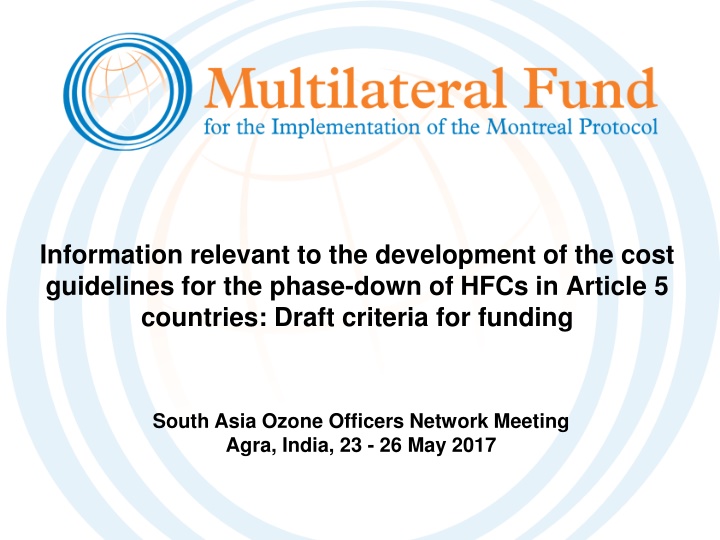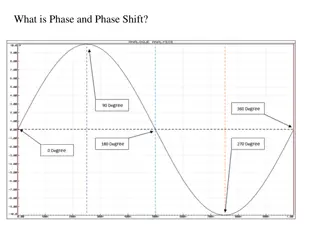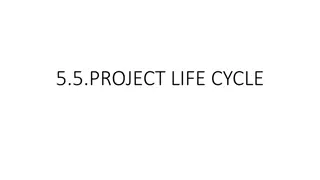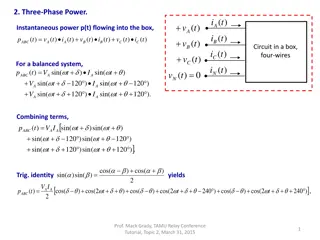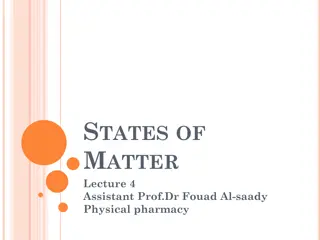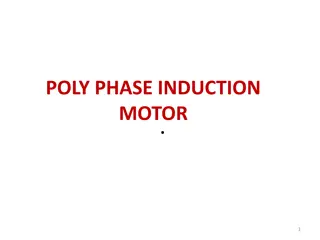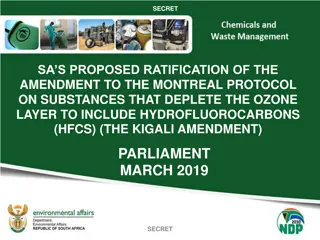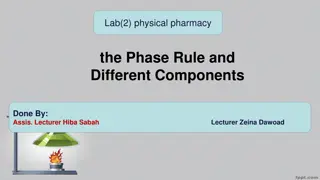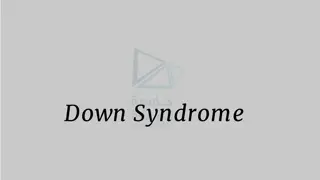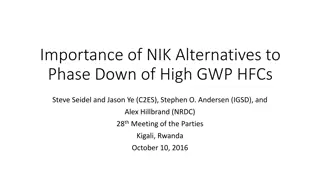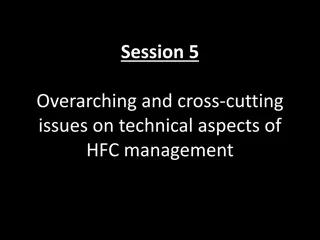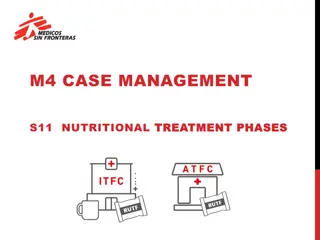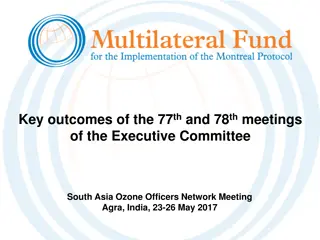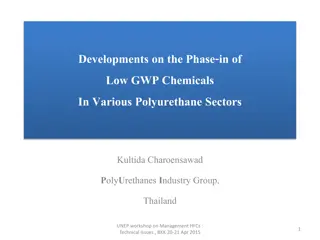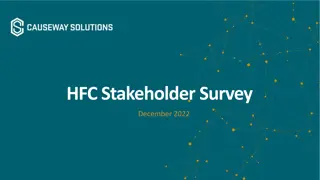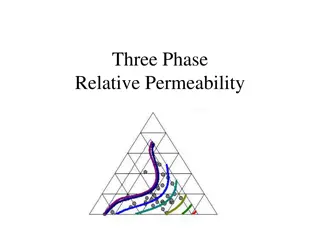Development of Cost Guidelines for HFC Phase-down in Article 5 Countries
Draft criteria for funding the South Asia Ozone Officers Network Meeting in Agra, India focused on developing guidelines for the phase-down of HFCs in Article 5 countries. The document outlines elements of decision XXVIII/2, including overarching principles, flexibility in implementation, eligible costs, institutional strengthening, energy efficiency, and more. It also discusses specific paragraphs of the decision related to Kigali Amendment application, technology reviews, exemptions for high-ambient-temperature parties, and the relationship with HCFC phase-out.
Download Presentation

Please find below an Image/Link to download the presentation.
The content on the website is provided AS IS for your information and personal use only. It may not be sold, licensed, or shared on other websites without obtaining consent from the author.If you encounter any issues during the download, it is possible that the publisher has removed the file from their server.
You are allowed to download the files provided on this website for personal or commercial use, subject to the condition that they are used lawfully. All files are the property of their respective owners.
The content on the website is provided AS IS for your information and personal use only. It may not be sold, licensed, or shared on other websites without obtaining consent from the author.
E N D
Presentation Transcript
Information relevant to the development of the cost guidelines for the phase-down of HFCs in Article 5 countries: Draft criteria for funding South Asia Ozone Officers Network Meeting Agra, India, 23 - 26 May 2017
Structure of document 78/5 Each element of decision XXVIII/2 includes: The relevant text of the decision Comments from Executive Committee members Information on decisions, guidelines and/or processes of the Parties or the Executive Committee Annexes: I: Template for draft cost guidelines for the phase-down of HFCs II: Decisions of the Executive Committee relevant to decision XXVIII/2 III: Rules of procedure of the Executive Committee IV: Information relating to the refrigeration servicing sector V: Information relating to energy efficiency No observations or recommendations are included (decision 77/59(b)) 10/7/2024 2
Structure of document 78/5 Paragraphs of decision XXVIII/2 9, 10, 11 and 12 Elements of the guidelines for phase-down of HFCs I. Overarching principles and timelines II. Flexibility in implementation (*) III. Cut-off date for eligible capacity (*) IV. Second and third conversions (*) IV. Sustained aggregate reductions in HFC consumption and production V. Enabling activities [1] VI. Eligible incremental costs Consumption manufacturing sector Production sector [2] Refrigeration servicing sector Other costs (*) VII. Institutional strengthening [3] IX. Energy efficiency X. Capacity building to address safety XI. Disposal XII. Eligibility of Annex F substances subject to high ambient temperature exemptions (*) 13 and 14 17 18 19 3, 20, 23 15 3, 15(a), 23 15(b) 3, 15(c), 16 and 23 25 21 22 3, 23 24 . 35 3/17/2017 3
Paragraphs of decision XXVIII/2 that did not call for specific action by Executive Committee 1 and 2: Application of specific paragraphs of the Kigali Amendment to different groups of countries 4 and 5: Requests to TEAP to conduct technology reviews 25 to 34 and 36 to 40: Criteria, conditions and the process for exemptions for high-ambient-temperature parties and other exemptions for the Parties. 6 to 8: Relationship with HCFC phase-out The Secretariat noted that these paragraphs may be relevant to HCFC phase-out and HFC phase-down, and hence they were considered in documents 78/5 and 78/8 10/7/2024 4
Relationship with HCFC phase-out Paragraph 6: To acknowledge the linkage between the HFC and HCFC reduction schedules relevant to sectors and the preference to avoid transitions from HCFC to high global-warming-potential (GWP) HFC and to provide flexibility if no other technically proven and economically viable alternatives are available Paragraph 7: To also acknowledge these linkages with respect to certain sectors, in particular industrial process refrigeration, and the preference to avoid transitions from HCFC to high-GWP HFCs and to be willing to provide flexibility, if no other alternatives are available, in cases where: (a) HCFC supply may be unavailable from existing allowable consumption, stocks as well as recovered/recycled material, and (b) It would allow for a direct transition at a later date from HCFC to low-GWP or zero-GWP alternatives Paragraph 8: To provide, prior to the commencement of the Article 5 HFC freeze and in the light of the acknowledgement in the paragraph above, flexibility measures in relation to the HCFC phase-out relevant to certain sectors, in particular the industrial process refrigeration subsector, in order to avoid double conversions 10/7/2024 5
Overarching principles and timelines (1) Paragraph 9: To recognize that the Amendment maintains the Multilateral Fund for the Implementation of the Montreal Protocol as the financial mechanism and that sufficient additional financial resources will be provided by Parties not operating under paragraph 1 of Article 5 to offset costs arising out of HFC obligations for Parties operating under paragraph 1 of Article 5 under the Amendment . Paragraph 10: To request the Executive Committee to develop, within two years of the adoption of the Amendment, guidelines for financing the phase-down of HFC consumption and production, including cost-effectiveness thresholds, and to present those guidelines to the Meeting of the Parties for the Parties views and inputs before their finalization by the Executive Committee . 10/7/2024 6
Overarching principles and timelines (2) Previous decisions and practices National strategies have been the basis for providing assistance to Article 5 countries to phase out ODS (paragraph 18 of document 78/5) Document 78/6 provides a comprehensive overview of strategies used by Article 5 countries over time, from country programmes to HPMPs In the case of the acceleration of HCFC phase-out, at its 53rd meeting (October 2007) the ExCom started discussing issues related to the funding of HCFC phase-out, including most suitable type of national HCFC phase-out strategy. Given that the baselines had not been established and there were uncertainties with respect to technologies, a staged approach was agreed (paragraph 19 of document 78/5) 10/7/2024 7
Overarching principles and timelines (3) Issues on which the ExCom reached agreement before agreeing on HCFC cost guidelines (para. 20 of document 78/5): The legal prerequisites for accessing Fund funding for HCFC phase-out (i.e., ratification of the Copenhagen Amendment for consumption and the Beijing Amendment for production) Continued applicability of the existing policies and guidelines in funding phase-out of ODS other than HCFCs Continued use of the institutions and capacities in Article 5 countries developed through Fund assistance Definitions of low-LVC countries and SMEs 10/7/2024 8
Overarching principles and timelines (4) Paragraph 11: To request the Chair of the Executive Committee to report back to the Meeting of the Parties on the progress made in accordance with this decision, including on cases where Executive Committee deliberations have resulted in a change in a national strategy or a national technology choice submitted to the Executive Committee . Previous decisions and practices The Chair of the ExCom provides a report at each MOP that describes the work of the ExCom since the previous MOP, including achievements, policies and projects approved (paragraph 22 of document 78/5) 10/7/2024 9
Overarching principles and timelines (5) The agenda of the 39th meeting of the OEWG includes an item on the update on the ExCom progress in relation to decision XXVIII/2 (could be made through a note prepared by the Secretariat on behalf of the ExCom or by any other manner (paragraph 22 of document 78/5) The Secretariat seeks guidance from the ExCom on how it wishes to update the Parties on its progress in relation to decision XXVIII/2 and on changes to the format of the report to the Parties, following paragraph 11 of decision XXVIII/2. (paragraph 23 of document 78/5) Paragraph 12: To request the Executive Committee to revise the rules of procedure of the Executive Committee with a view to building in more flexibility for Parties operating under paragraph 1 of Article 5 (Annex III of document 78/5) 10/7/2024 10
Flexibility in implementation (1) Paragraph 13: Parties operating under paragraph 1 of Article 5 will have flexibility to prioritize HFCs, define sectors, select technologies and alternatives and elaborate and implement their strategies to meet agreed HFC obligations, based on their specific needs and national circumstances, following a country-driven approach . Paragraph 14: To request the Executive Committee of the Multilateral Fund to incorporate the principle referred to in the paragraph above into relevant funding guidelines for the phase down of HFCs and in its decision-making process . 10/7/2024 11
Flexibility in implementation (2) Previous decisions and practices General principles of incremental costs (paragraph 28 of document 78/5) The most cost-effective and efficient option should be chosen, taking into account the national industrial strategy of the recipient Party Consideration of project proposals for funding should involve the careful scrutiny of cost items listed in an effort to ensure that there is no double-counting Savings or benefits that will be gained at both the strategic and project levels during the transition process should be taken into account on a case-by-case basis Funding of incremental costs is intended as an incentive for early adoption of ozone protecting technologies. Time scales for payment of incremental costs was agreed 10/7/2024 12
Flexibility in implementation (3) Decision XIX/6 requested the ExCom to give priority to cost-effective projects and programmes which focus on, inter alia phasing out first those HCFCs with higher ODP, taking into account national circumstances (paragraph 29(a) of document 78/5) Substitutes and alternatives that minimize other impacts on the environment, including on the climate, taking into account GWP, energy use and other relevant factors; and SMEs (paragraph 29(a) of document 78/5) Decision 59/11 requested agencies to submit as a priority HCFC- 141b phase-out projects Decision 60/44 (stage I of HPMPs) established that non-LVC countries should first address consumption in the manufacturing sector, achieve 2013 and 2015 targets, and that funding for servicing would be provided if such countries clearly demonstrated that they required assistance in this sector to comply with these targets (paragraph 29(b) of document 78/5) 10/7/2024 13
Flexibility in implementation (4) Decision 62/12 requested additional justification for the submission of projects in sectors not considered as a priority Decision 72/18 reminded agencies and Article 5 countries to prioritize the phase-out of HCFC-141b and compliance with the 2020 target when requesting and using project preparation funds for projects in non-LVC countries (paragraph 29(b) of document 78/5) Decision 74/50 (stage II of HPMPs) established that non-LVC countries should prioritize consumption in the manufacturing sector for meeting reduction targets (paragraph 29(b) of document 78/5) Flexibility has been applied when required, e.g., include sectors that were not considered priority (e.g., refrigeration servicing sector); continue using HCFCs in certain applications; submit stand-alone projects when a suitable technology was identified. As a result, refrigeration servicing sector has been approved in all countries that have requested funding for this sector (paragraph 29(c) of document 78/5) 10/7/2024 14
Flexibility in implementation (5) There have been instances in which three or more sectors in a country have received the same priority resulting in a proposal to phase out more consumption of HCFCs than would be required to comply with the next reduction target. Each of these cases has been discussed in light of the circumstances of the country, resulting in the approval of the strategy as submitted in many cases. In other cases, additional HCFC reduction commitments, longer implementation periods and/or prioritization of some sectors over others (paragraph 29(d) of document 78/5) Outcome of discussions at the 78th meeting The ExCom decided to include paragraph 13 of decision XXVIII/2 in in the relevant section of the draft template of the cost guidelines for the phase-down of HFCs (decision 78/3(b)) 10/7/2024 15
Cut-off date for eligible capacity Paragraph 17: That the cut-off date for eligible capacity is 1 January 2020 for those Parties with baseline years from 2020 to 2022 and 1 January 2024 for those Parties with baseline years from 2024 to 2026 Outcome of discussions at the 78th meeting The Executive Committee decided to include paragraph 17 of decision XXVIII/2 in in the relevant section of the draft template of the cost guidelines for the phase-down of HFCs contained in Annex I to document 78/11 (decision 78/3(c)) 10/7/2024 16
Second and third conversions (1) Paragraph 18: To request the Executive Committee to incorporate the following principles relating to second and third conversions into funding guidelines: a) First conversions, in the context of a phase-down of HFCs, are defined as conversions to low-GWP or zero-GWP alternatives of enterprises that have never received any direct or indirect support, in part or in full, from the Multilateral Fund, including enterprises that converted to HFCs with their own resources b) Enterprises that have already converted to HFCs in phasing out CFCs and/or HCFCs will be eligible to receive funding from the Multilateral Fund to meet agreed incremental costs in the same manner as enterprises eligible for first conversions c) Enterprises that convert from HCFCs to high-GWP HFCs, after the date of adoption of the Amendment, under HCFC phase-out management plans already approved by the Executive Committee will be eligible to receive funding from the Multilateral Fund for a subsequent conversion to low- GWP or zero-GWP alternatives to meet agreed incremental costs in the same manner as enterprises eligible for first conversions 10/7/2024 17
Second and third conversions (2) d) Enterprises that convert from HCFCs to high-GWP HFCs with their own resources before 2025 under the Amendment will be eligible to receive funding from the Multilateral Fund to meet agreed incremental costs in the same manner as enterprises eligible for first conversions; and Enterprises that convert from HFCs to lower-GWP HFCs with Multilateral Fund support when no other alternatives are available will be eligible to receive funding from the Multilateral Fund for a subsequent conversion to low-GWP or zero-GWP alternatives if necessary to meet the final HFC phase-down step . e) Outcome of discussions at the 78th meeting The ExCom decided to include paragraph 18 of decision XXVIII/2 in the relevant section of the draft template of the cost guidelines for the phase- down of HFCs (decision 78/3(d)) 10/7/2024 18
Sustained aggregate reduction in HFC production and consumption (1) Paragraph 19: To request the Executive Committee to incorporate the following principle related to sustained aggregate reductions into Multilateral Fund policies: remaining eligible consumption for funding in tonnage will be determined on the basis of the starting point of national aggregate consumption less the amount funded by previously approved projects in future multi year agreement templates for HFC phase- down plans, consistent with Executive Committee decision 35/57 Previous decisions and practices At the 35th meeting, the ExCom agreed inter alia that further funding must be predicated on a commitment by the country to achieve sustainable permanent aggregate reductions in consumption and production, as relevant (paragraph 33 of document 78/5) The ExCom believed that all Article 5 countries should be treated equally. Each country should select one of two options for determining the starting point for implementation of its national aggregate consumption: MP baseline less projects approved but not yet implemented when the baseline was established, and projects approved since (option 1); or, latest reported data (1999 or 2000) less projects approved but not yet implemented (option 2) (para. 34 of document 78/5) 10/7/2024 19
Sustained aggregate reduction in HFC production and consumption (2) The ExCom acknowledged that some future years reported consumption could go above or below the levels that resulted from the agreed calculation, but if consumption numbers went above the resulting levels, such increases in consumption would not be eligible for funding (para. 35 of document 78/5) For the phase-out of HCFCs, Article 5 Parties could choose between two options to establish their starting point: the most recent reported HCFC consumption under Article 7 at the time of the submission of the HPMP and/or the investment project, or the country s forecast baseline HCFC consumption. If the latter was chosen, the starting point would be adjusted once the HCFC baseline was known (paragraph 37 of document 78/5) Outcome of discussions at the 78th meeting The ExCom decided to continue discussions on: the methodology for determining the starting point (including whether it would be expressed in CO2 equivalents, metric tonnes, or both) and the inclusion of paragraph 19 of decision XXVIII/2 in the relevant section of the draft template of the cost guidelines for the phase-down of HFCs (decision 78/3(e)) 10/7/2024 20
Enabling activities Paragraph 20: To request the Executive Committee to include the following enabling activities to be funded in relation to HFC phase- down under the Amendment: (a) Capacity-building and training for handling HFC alternatives in the servicing, manufacturing and production sectors; (b) Institutional strengthening; (c) Article 4B licensing; (d) Reporting; (e) Development of national strategies; and (f) Demonstration projects ExCom considered enabling activities in a separate agenda item based on document 78/6 prepared by the Secretariat (paragraph 40 of document 78/5)) 10/7/2024 21
Eligible incremental costs (1) Paragraph 15: To request the Executive Committee, in developing new guidelines on methodologies and cost calculations, to make the following categories of costs eligible and to include them in the cost calculation . Paragraph 15(a): For the consumption manufacturing sector: (i) Incremental capital costs (ICC); (ii) Incremental operating costs (IOC) for a duration to be determined by the Executive Committee; (iii) Technical assistance activities; (iv) Research and development, when required to adapt and optimize low-GWP or zero-GWP alternatives to HFCs; (v) Costs of patents and designs, and incremental costs of royalties, when necessary and cost-effective; and (vi) Costs of the safe introduction of flammable and toxic alternatives . 10/7/2024 22
Eligible incremental costs (2) Paragraphs of document 78/5 with information on relevant decisions on: 44 to 56: cost-effectiveness thresholds and incremental capital costs. 57 to 64: incremental operating costs 65 to 69: technical assistance costs 70 to 76: research and development for adapting and optimising alternatives 77 to 81: cost of patents, designs and royalties 82 to 87: cost of safe introduction of flammable and toxic alternatives Outcome at the 78th meeting ExCom decided to make six categories of costs eligible and include them in the cost calculation in the consumption manufacturing sector (Annex I to document 78/11) ExCom would consider approving a limiting number of HFC projects in the manufacturing sector only ExCom would consider costs and savings related to opportunities for further avoiding HFCs in HCFC phase-out activities and how they could be addressed (decision 78/3(f)-(h)) 10/7/2024 23
Eligible incremental costs (3) Paragraph 15(b): For the production sector: (i) Lost profit due to the shutdown/closure of production facilities as well as production reduction; (ii) Compensation to displaced workers; (iii) Dismantling of production facilities; (iv) Technical assistance activities; (v) Research and development related to the production of low-GWP or zero-GWP alternatives to hydrofluorocarbons with a view to lowering the costs of alternatives; (vi) Costs of patents and designs or incremental costs of royalties; (vii) Costs of converting facilities to produce low-GWP or zero-GWP alternatives to hydrofluorocarbons when technically feasible and cost-effective; (viii) Costs of reducing emissions of HFC-23, a by-product from the production process of HCFC-22, by reducing its emission rate in the process, destroying it from the off-gas, or by collecting and converting it to other environmentally safe chemicals. Such costs should be funded by the Multilateral Fund to meet the obligations of Parties operating under paragraph 1 of Article 5 specified under the Amendment . 10/7/2024 24
Eligible incremental costs (4) Previous decisions and practices Paragraphs 91 to 95 of document 78/5 provide information relating to costs of production sector phase-out during CFC phase-out and HCFC phase-out Paragraph 15(c): For the servicing sector: (i) Public-awareness activities; (ii) Policy development and implementation; (iii) Certification programmes and training of technicians on safe handling, good practice and safety in respect of alternatives, including training equipment; (iv) Training of customs officers; (v) Prevention of illegal trade of HFCs; (vi) Servicing tools; (vii) Refrigerant testing equipment for the refrigeration and air-conditioning sector; (viii)Recycling and recovery of HFCs . 10/7/2024 25
Eligible incremental costs (5) Paragraph 16: To request the Executive Committee to increase in relation to the servicing sector the funding available under decision 74/50 above the amounts listed in that decision for Parties with total HCFC baseline consumption up to 360 metric tonnes when needed for the introduction of alternatives to HCFCs with low-GWP and zero-GWP alternatives to HFCs and maintaining energy efficiency also in the servicing/end-user sector . Previous decisions and practices Paragraphs 99 to 104 of document 78/5 provide information on costs on refrigeration servicing during CFC and HCFC phase-out Annex IV to document 78/5 includes comprehensive nformation relating to the refrigeration servicing sector Paragraph 25: The Parties may identify other cost items to be added to the indicative list of incremental costs emanating as a result of the conversion to low-GWP alternatives . No discussion at the 78th meeting 10/7/2024 26
Institutional strengthening Paragraph 21: To direct the Executive Committee to increase IS support in light of new commitments related to HFCs under this Amendment . Previous decisions and practices Presented in document 78/7, considering the relevance of institutional strengthening for the implementation of the Montreal Protocol 10/7/2024 27
Energy efficiency Paragraph 22: To request the Executive Committee to develop cost guidance associated with maintaining and/or enhancing the energy efficiency of low-GWP or zero-GWP replacement technologies and equipment, when phasing down HFCs, while taking note of the role of other institutions addressing energy efficiency, when appropriate Previous decisions and practices Paragraphs 111 to 114 of document 78/5 provide on how energy efficiency components were considered during CFC and HCFC phase-out Annex V to document 78/5 presents an overview of information on maintaining/enhancing energy efficiency 10/7/2024 28
Capacity building to address safety Paragraph 23: To request the Executive Committee to prioritize technical assistance and capacity building to address safety issues associated with low-GWP or zero-GWP alternatives . Paragraph 3: To recognize the importance of timely updating international standards for flammable low-global-warming potential (GWP) refrigerants, including IEC60335-2-40, and to support promoting actions that allow safe market introduction, as well as manufacturing, operation, maintenance and handling, of zero GWP or low-GWP refrigerant alternatives to HCFCs and HFCs . This paragraph, while not having a mandate to the Executive Committee, is related to the subject. Previous decisions and practices Document 78/6 presents a comprehensive analysis including the previous decisions and practices related to enabling activities. 10/7/2024 29
Disposal Paragraph 24: To request the Executive Committee to consider funding the cost effective management of stockpiles of used or unwanted controlled substances, including destruction . Previous decisions and practices Paragraphs 118 to 124 of document 78/5 provide information on policies and projects relating to ODS disposal activities 10/7/2024 30
Eligibility of Annex F substances subject to high ambient temperature exemptions The Parties made available an exemption for Parties with high- ambient temperature conditions where suitable alternatives do not exist for the specific sub-sector of use (paragraphs 26 to 40 of decision XXVIII/2. On funding (paragraph 35 , the Parties indicated that amounts of Annex F substances that are subject to the high ambient temperature exemption are not eligible for funding under the Multilateral Fund while they are exempted for that party. (paragraph 125 of document 78/5) Previous decisions and practices Paragraphs 128 to 131 of document 78/5 provide information on policies and procedures adopted in relating to such exempt uses No discussion at the 78th meeting 10/7/2024 31
Decision 78/3 (1) The Executive Committee decided: (a) To take note of the information relevant to the development of the cost guidelines for the phase-down of HFCs in Article 5 countries: draft criteria for funding contained in documents UNEP/OzL.Pro/ExCom/78/5 and Corr.1; In relation to flexibility in implementation that enables Parties to select their own strategies and priorities in sectors and technologies (b) To include paragraph 13 of decision XXVIII/2 in the relevant section of the draft template of the cost guidelines for the phase-down of HFCs contained in Annex I to the present report; In relation to the cut-off date for eligible capacity (c) To include paragraph 17 of decision XXVIII/2 in the relevant section of the draft template of the cost guidelines for the phase-down of HFCs contained in Annex I to the present report; 10/7/2024 32
Decision 78/3 (2) In relation to second and third conversions (d) To include paragraph 18 of decision XXVIII/2 in the relevant section of the draft template of the cost guidelines for the phase-down of HFCs contained in Annex I to the present report; In relation to sustained aggregate reductions in HFC consumption and production (e) To continue discussions on: (i) The methodology for determining the starting point, including whether it would be expressed in CO2 equivalents, metric tonnes, or both; The inclusion of paragraph 19 of decision XXVIII/2 in the relevant section of the draft template of the cost guidelines for the phase-down of HFCs; (ii) 10/7/2024 33
Decision 78/3 (3) In relation to eligible incremental costs For the consumption manufacturing sector (f) In accordance with paragraph 15(a) of decision XXVIII/2, to make the following categories of costs eligible and to include them in the cost calculation associated with the phase-down of HFCs in the consumption manufacturing sector contained in Annex I to the present report: (i) Incremental capital costs (ICCs); (ii) Incremental operating costs (IOCs) for a duration to be determined by the Executive Committee; (iii) Technical assistance activities; (iv) Research and development, when required to adapt and optimize alternatives to HFCs with low- or zero-global warming potential; (v) Costs of patents and designs, and incremental costs of royalties, when necessary and cost effective; (vi) Costs of the safe introduction of flammable and toxic alternatives; 10/7/2024 34
Decision 78/3 (4) In relation to eligible incremental costs For the consumption manufacturing sector (g) To consider approving a limited number of HFC-related projects in the manufacturing sector only, without prejudice to different kinds of technology, no later than at the first meeting of 2019, to allow the Committee to gain experience in the ICCs and IOCs that might be associated with phasing down HFCs in Article 5 countries, on the understanding: that any Article 5 country that submitted a project should have ratified the Kigali Amendment or submitted a formal letter indicating the government s intention to ratify the Amendment; that no further funding would be available until the instrument of ratification had been received by the depositary at the Headquarters of the United Nations in New York; and that any amount of HFC reduced as a result of the project would be deducted from the starting point; (h) To consider costs and savings related to opportunities for further avoiding HFCs in HCFC phase-out activities and how they could be addressed; and 10/7/2024 35
Decision 78/3 (5) For the other matters discussed in relation to document 78/5 (i) To request the Secretariat to prepare a document containing the elements of decision XXVIII/2 presented by the Chair of the Executive Committee in his written summary of discussions on agenda item 6(a), Information relevant to the development of the cost guidelines for the phase-down of HFCs in Article 5 countries, at the 78th meeting, for further consideration by the Executive Committee at its 79th meeting, including a summary of the issues pending, such as eligible incremental costs (consumption manufacturing, production sector, refrigeration servicing sector, and other costs), energy efficiency, capacity building to address safety, disposal and eligibility of Annex F substances subject to high- ambient-temperature exemptions. 10/7/2024 36
Actions Thorough review of: decision XXVIII/2; previous decisions and practices of the ExCom and the Parties; and information set out in documents 78/5 and Corr.1 Thorough review of the discussion at the 78th meeting contained in the report of the 78th meeting (document 78/11) Discussions with key Government authorities at the country level and with Government authorities of Article 5 countries Convey your national views to Government officials of Article 5 countries as members of the ExCom Thorough review of documents for all subsequent meetings of the ExCom and the Parties 10/7/2024 37
Thank you! 10/7/2024 38
